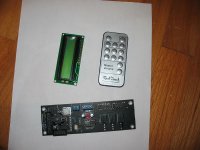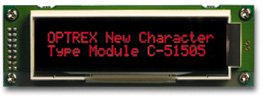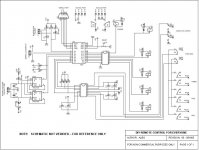Moderators,
Would you please move the BasicStamp postings from the “High End Pre Group Design Invitation” thread over to this thread? Fear that suggestion of alternative micro-controller was un-welcome and would like to start fresh with a new thread for those interested.
Thank you -ALBQ
Would you please move the BasicStamp postings from the “High End Pre Group Design Invitation” thread over to this thread? Fear that suggestion of alternative micro-controller was un-welcome and would like to start fresh with a new thread for those interested.
Thank you -ALBQ
Summary,
Suggestion was to build a remote controlled preamplifier using a Basic microcontroller such as a BasicStamp, BasicAtom or BasicX microcontroller. Although slower than a PIC or Ubicom, the controller can be programmed in basic using free downloadable software. The advantage of such a solution for the DIY community is that it takes minimal software knowledge to get it working and, can be easily modified at by the end user. This means that once a basic design is developed, people are free to build upon it.
Oh, on your question, was thinking more along the lines of IR remote but, hey - its for everyone so, why not
Cheers -ALBQ
Suggestion was to build a remote controlled preamplifier using a Basic microcontroller such as a BasicStamp, BasicAtom or BasicX microcontroller. Although slower than a PIC or Ubicom, the controller can be programmed in basic using free downloadable software. The advantage of such a solution for the DIY community is that it takes minimal software knowledge to get it working and, can be easily modified at by the end user. This means that once a basic design is developed, people are free to build upon it.
Oh, on your question, was thinking more along the lines of IR remote but, hey - its for everyone so, why not
Cheers -ALBQ
An externally hosted image should be here but it was not working when we last tested it.
BS2 code and specifications for above:
BS2 source code:
http://mywebpages.comcast.net/gillespie147/Junk/PGA2310-DigitalVolume-Encoder.bs2
Specifications:
* BasicStamp2 micro (will migrate to BasicAtom)
* PGA2310PA - digital volume control (256 step)
* IR - function (power, volume, mute & IO control)
* LCD display - on/off greeting, volume setting, mute, function
* Rotary Encoder volume control
* +/-9V Analog PS w/switching for when unit is off
* +5V-9V Digital power - onboard filter network to wallwort
Still to go:
- Migrate code to BasicAtom - more speed, power & memory
- Add switch inputs - for manual control (74C922)
- Write code for balance control via rotary encoder (mult func)
- Change LCD for VFD
- Final design of power supplies
- Draw and etch PCBs
- Put it in a box
BS2 source code:
http://mywebpages.comcast.net/gillespie147/Junk/PGA2310-DigitalVolume-Encoder.bs2
Specifications:
* BasicStamp2 micro (will migrate to BasicAtom)
* PGA2310PA - digital volume control (256 step)
* IR - function (power, volume, mute & IO control)
* LCD display - on/off greeting, volume setting, mute, function
* Rotary Encoder volume control
* +/-9V Analog PS w/switching for when unit is off
* +5V-9V Digital power - onboard filter network to wallwort
Still to go:
- Migrate code to BasicAtom - more speed, power & memory
- Add switch inputs - for manual control (74C922)
- Write code for balance control via rotary encoder (mult func)
- Change LCD for VFD
- Final design of power supplies
- Draw and etch PCBs
- Put it in a box
Banned
Joined 2002
ALBQ said:BS2 code and specifications for above:
BS2 source code:
http://mywebpages.comcast.net/gillespie147/Junk/PGA2310-DigitalVolume-Encoder.bs2
Specifications:
* BasicStamp2 micro (will migrate to BasicAtom)
* PGA2310PA - digital volume control (256 step)
* IR - function (power, volume, mute & IO control)
* LCD display - on/off greeting, volume setting, mute, function
* Rotary Encoder volume control
* +/-9V Analog PS w/switching for when unit is off
* +5V-9V Digital power - onboard filter network to wallwort
Still to go:
- Migrate code to BasicAtom - more speed, power & memory
- Add switch inputs - for manual control (74C922)
- Write code for balance control via rotary encoder (mult func)
- Change LCD for VFD
- Final design of power supplies
- Draw and etch PCBs
- Put it in a box
I like it
So this is a neat programmable switchbox and volume control, not an active pre-amp, right? Could I add an active preamp into the mix without too much trouble?
Any idea on what the costs are approximately?
Regards,
Michael
Michael,
Somewhat - with a PGA2310 you could go either way. Leave it as is, would not exactly call it passive or add a stage of your choosing. Total cost as you see it is around $150, maybe a little less.
My earlier design:
http://mywebpages.comcast.net/gillespie147/12AU7-Preamp.html
Somewhat - with a PGA2310 you could go either way. Leave it as is, would not exactly call it passive or add a stage of your choosing. Total cost as you see it is around $150, maybe a little less.
My earlier design:
http://mywebpages.comcast.net/gillespie147/12AU7-Preamp.html
An externally hosted image should be here but it was not working when we last tested it.
Banned
Joined 2002
Banned
Joined 2002
An Excellent Piece of work
ALBQ:
An excellent piece of work and code that you have posted is absolutely fantastics, hats off to u.
Suggestion
If u would readjust the code like at the time of powerup it mute for say about 1 sec so that "thump" generated by PGA is cancelled. Adding a bargraph in the second row showing volume level at the time of level changes will be a cool idea.
ALBQ:
An excellent piece of work and code that you have posted is absolutely fantastics, hats off to u.
Suggestion
If u would readjust the code like at the time of powerup it mute for say about 1 sec so that "thump" generated by PGA is cancelled. Adding a bargraph in the second row showing volume level at the time of level changes will be a cool idea.
abidr,
Thank you. Yes, mute needs to be on during on/off just, trying to get all of the different hardware and software code segments together. The hard part of such a project is getting all of the different hardware/code routines working. Once I get it together, will start the fit and finish work.
I will really try to get a complete schematic posted during the weekend. This way people can put all of the pieces together.
Thank you again -ALBQ
Thank you. Yes, mute needs to be on during on/off just, trying to get all of the different hardware and software code segments together. The hard part of such a project is getting all of the different hardware/code routines working. Once I get it together, will start the fit and finish work.
I will really try to get a complete schematic posted during the weekend. This way people can put all of the pieces together.
Thank you again -ALBQ
DIT Remote Control for Everyone
Jajabin,
The IR detector is a Panasonic PNA4602. Contains both the IR detector and 38khz filter all in a single 3 pin package. See attached datasheet
On the code side, space and floating point math are the primary reasons I am migrating the code to a BasicAtom. An Atom has something like 14k of program space in a single bank, does floating point math and runs at 33khz. This compares to 2K program space, integer math and 4khz for a BS2. For receiving IR commands, doing basic i/o, sending serial control codes and actuating relays, speed is not a requirement but, the program space and math are a real plus. I am not so sure about the need to return settings at power-up… hmmm, working with serial eeproms is not terribly difficult but, unless you are adding surround sound or functions that require holding settings in memory, probably not necessary. What are your thoughts?
Cheers -ALBQ
Jajabin,
The IR detector is a Panasonic PNA4602. Contains both the IR detector and 38khz filter all in a single 3 pin package. See attached datasheet
On the code side, space and floating point math are the primary reasons I am migrating the code to a BasicAtom. An Atom has something like 14k of program space in a single bank, does floating point math and runs at 33khz. This compares to 2K program space, integer math and 4khz for a BS2. For receiving IR commands, doing basic i/o, sending serial control codes and actuating relays, speed is not a requirement but, the program space and math are a real plus. I am not so sure about the need to return settings at power-up… hmmm, working with serial eeproms is not terribly difficult but, unless you are adding surround sound or functions that require holding settings in memory, probably not necessary. What are your thoughts?
Cheers -ALBQ
Attachments
Banned
Joined 2002
jleaman,
Yes, was even thinking about a couple boards. Board that could work as a standalone or back of a faceplate to hold the microcontroller, display, switches, IR detection and rotary encoder. Then separate boards for the analog power supply and relays. Alternatively, could do an all-in-one design with only the digital and analog power supplies off board. Have not decided yet - what are your thoughts?
Also, getting a PGA2310 or CS3310 to sound good (imho) is mostly dependent on closely following the design guide and the quality of the power supply so, isolation, filtering, analog grounding/routing are important design considerations
Thank you -ALBQ
Yes, was even thinking about a couple boards. Board that could work as a standalone or back of a faceplate to hold the microcontroller, display, switches, IR detection and rotary encoder. Then separate boards for the analog power supply and relays. Alternatively, could do an all-in-one design with only the digital and analog power supplies off board. Have not decided yet - what are your thoughts?
Also, getting a PGA2310 or CS3310 to sound good (imho) is mostly dependent on closely following the design guide and the quality of the power supply so, isolation, filtering, analog grounding/routing are important design considerations
Thank you -ALBQ
Banned
Joined 2002
ALBQ said:jleaman,
Yes, was even thinking about a couple boards. Board that could work as a standalone or back of a faceplate to hold the microcontroller, display, switches, IR detection and rotary encoder. Then separate boards for the analog power supply and relays. Alternatively, could do an all-in-one design with only the digital and analog power supplies off board. Have not decided yet - what are your thoughts?
Also, getting a PGA2310 or CS3310 to sound good (imho) is mostly dependent on closely following the design guide and the quality of the power supply so, isolation, filtering, analog grounding/routing are important design considerations
Thank you -ALBQ
Me think's
Ditch the PGA2310 and do a nice motorized pot or a relay volume pot something hi end.. with a nice lcd read out of the volume level mute input selector.. i think a nice stepped attenuator would be better and you would attract more fly's
I'm also trying to produce a product like this but if i can work with this instead of against it i will..
J'
jleaman,
A couple of things:
My previous design and current preamp uses an ALPs motorized pot, inlcudes a backlit LCD display and has 4 inputs plus, tape monitor and mute. This is not to mention some code I have not posted with bells & whistles. So, I have already built what you are proposing - yes, I listened to it in in passive mode as well
I have no desire to offer this as a commercial product at this time. I have seen countless posts, adds and offers to the DIY community for simple remote control capability. Offering something with no expectation of monetary gain is my gift to a community of fellow enthusiasts desperately in need of an easy to build and understand remote control. This design is easy and flexible enough, that it just might be that solution.
It is my sincere hope that I can provide people with a design they can customize and call their own
Thank you –ALBQ
My current preamp:
http://mywebpages.comcast.net/gillespie147/12AU7-Preamp.html
A couple of things:
My previous design and current preamp uses an ALPs motorized pot, inlcudes a backlit LCD display and has 4 inputs plus, tape monitor and mute. This is not to mention some code I have not posted with bells & whistles. So, I have already built what you are proposing - yes, I listened to it in in passive mode as well
I have no desire to offer this as a commercial product at this time. I have seen countless posts, adds and offers to the DIY community for simple remote control capability. Offering something with no expectation of monetary gain is my gift to a community of fellow enthusiasts desperately in need of an easy to build and understand remote control. This design is easy and flexible enough, that it just might be that solution.
It is my sincere hope that I can provide people with a design they can customize and call their own
Thank you –ALBQ
My current preamp:
http://mywebpages.comcast.net/gillespie147/12AU7-Preamp.html
Banned
Joined 2002
DIT Remote Control for Everyone
All,
Here is a REV0 schematic for reference. I have not had time to carefully walk through it so, it is not yet verified and may contain errors. That said, I wanted to post a REV0 schematic so that people could get an idea of the design and how the hardware fits with the code
Cheers -ALBQ
All,
Here is a REV0 schematic for reference. I have not had time to carefully walk through it so, it is not yet verified and may contain errors. That said, I wanted to post a REV0 schematic so that people could get an idea of the design and how the hardware fits with the code
Cheers -ALBQ
Attachments
All,
Updated BS2 code to fix a typo in a line that was turning off the power when switching channels and added 1sec output muting during power-on to silence turn-on thump of the PGA2310
Cheers -ALBQ
Latest source code:
http://mywebpages.comcast.net/gillespie147/Junk/PGA2310-DigitalVolume-Encoder.bs2

Updated BS2 code to fix a typo in a line that was turning off the power when switching channels and added 1sec output muting during power-on to silence turn-on thump of the PGA2310
Cheers -ALBQ
Latest source code:
http://mywebpages.comcast.net/gillespie147/Junk/PGA2310-DigitalVolume-Encoder.bs2

- Status
- This old topic is closed. If you want to reopen this topic, contact a moderator using the "Report Post" button.
- Home
- Amplifiers
- Chip Amps
- DIY Remote Control for Everyone


